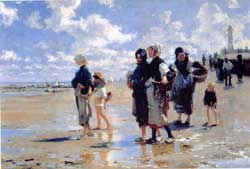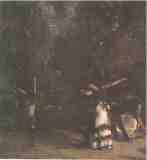
|
The very first submission Sargent made to the Salon jury in 1877 was accepted: "Fanny" Watts. This was a notable distinction for a first time submission and big things were expected from this young artist. From early on, from his second year submitting (1878), Sargent developed a plan that he would duplicate. It was quite simple and quite effective. On the one hand, he would continue his work with portraits, mastering his teacher even surpassing him. On the other hand he would experiment with scene painting, or something more exotic taken from his travels. It was here that he would take risks and push at the boundaries of his art, showing Parisians he was capable of much more than portraiture. In 1878 it was his scene painting Oyster Gatherers of Cancale got the attention of the public. The following year, 1879, A Capriote got mixed reviews -- New York loved it, Paris found it odd. Sargent wasn't concerned. His submission of the portrait of his teacher Carolus-Duran got a resounding applause from the public and receives an Honorable Mention -- a triumph of Carolus-Duranís own student. The reception was so warm, in fact, that Sargent found his relationship with his teacher a bit strained (much to John's distress). But it was time for him to move on. John could sense his destiny. Not only was he a good artist, but he was being recognized as one of the better artists of his contemporaries. It wouldn't do anymore to just get displayed at the Salon each year. He had a real chance of getting top honors and being recognized as the best -- and he knew it. That summer (1879), after the Salon, John begins to look for other artistic influences to further broaden his cache. When he traveled to Spain to study Velazquez (1599-1660) and the dark tonal paintings, he also was being influenced by contemporary artists, as any artist is. In Sargent's case, it was the Impressionist movement of Manet and Degas who where, in turn influenced by the growing popularity of Japanese prints. Another expatriate American artist influenced by these prints was James McNeill Whistler (1834-1903). Whistler had been the first American painter to become famous in Europe. A Southern dandy, Whistler was as renown for his personality as his art. In many ways, Sargent's early years parralleled Whistler's popularity. Besides Whistler, there was no other American painter that could move through Parisian society as easily as Sargent. And none had such promise. |
|
|||||
|
By
the time Sargent returned to Paris in '79, word had most certainly reached
France about Whistler suing John Ruskin for libel. Whistler had shown his
painting Nocturne in Black and Gold: The Falling Rocket at the Grosvenor
Gallery, London, and Ruskin, having seen the painting declared in print:
ďI have seen, and heard, much of Cockney impudence before now; but never expected to hear a coxcomb ask two hundred guineas for flinging a pot of paint in the public's face."The quote was repeated over and over in the press and Whistler sued. The uproar captivated the young Sargent (1). Whistler had not been a stranger
to controversy. In 1862 his The White Girl (Symphony in White, No. 1)
was rejected by the Royal Academy, and then by the Paris Salon only
to be shown by the now famous "Salon des Refusés" where it caused
a furor. It would be these two Whistler paintings that would influences
Sargentís own two interpretations of black and white -- Spanish Dance
and Fumée d'Ambre Gris respectively.
|

|


